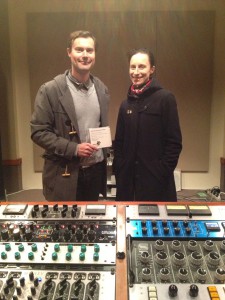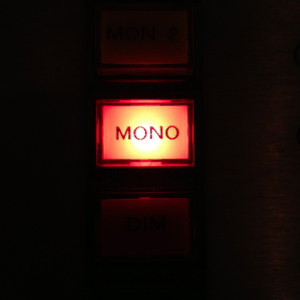Shop
Amidst computer and software upgrades here at Deluxe Mastering (described by Adam Dempsey as “faster, quieter, RAM-er, better-er”), Tony “Jack the Bear” Mantz has been mastering for Captain Midnite, Pharoah’s Playground, Indiago, Moonshifter, Artemis, Pretty City, Torch The Village, the USA’s Jonny Craig, Modavia, Riki Lindsey, Mez Yasumo and Scwat.
Adam Dempsey has mastered releases for The Bon Scotts, Charlie Lim, Matt Bailey (produced by Brent Punshon, engineered and mixed by Neil Thomason at Head Gap studios), Osh10 (mixed by Myles Mumford in Swaziland), Matt Glass (tracked and mixed by Fraser Montgomery at The Aviary), Hunting Bears (NZ), The Morrisons for CD and vinyl, Andy Lacy, The Critique, another single for Hoodlem, and this year’s NMIT Bachelor of Music triple album compilation, with producers including Greg Arnold, David Haberfeld, Shane O’Mara, Andy White and Peter Farnan.
Adam also congratulates Melbourne band I’ll Be An Indian – winners of this year’s Triple R Radiothon Band Prize for mastering.
Andrei Eremin has been mastering for Brightly, Squarehead, Banoffee, Milwaukee Banks, Sex On Toast and Lower Spectrum.
Amidst computer and software upgrades here at Deluxe Mastering (described by Adam Dempsey as “faster, quieter, RAM-er, better-er”), Tony “Jack the Bear” Mantz has been mastering for Captain Midnite, Pharoah’s Playground, Indiago, Moonshifter, Artemis, Pretty City, Torch The Village, the USA’s Jonny Craig, Modavia, Riki Lindsey, Mez Yasumo and Scwat.
Adam Dempsey has mastered releases for The Bon Scotts, Charlie Lim, Matt Bailey (produced by Brent Punshon, engineered and mixed by Neil Thomason at Head Gap studios), Osh10 (mixed by Myles Mumford in Swaziland), Matt Glass (tracked and mixed by Fraser Montgomery at The Aviary), Hunting Bears (NZ), The Morrisons for CD and vinyl, Andy Lacy, The Critique, another single for Hoodlem, and this year’s NMIT Bachelor of Music triple album compilation, with producers including Greg Arnold, David Haberfeld, Shane O’Mara, Andy White and Peter Farnan.
Adam also congratulates Melbourne band I’ll Be An Indian – winners of this year’s Triple R Radiothon Band Prize for mastering.
Andrei Eremin has been mastering for Brightly, Squarehead, Banoffee, Milwaukee Banks, Sex On Toast and Lower Spectrum.
Shop
Some of the latest projects through the mastering studio recently, with many thanks to our clients:
Tony “Jack the Bear” Mantz has been keeping out of mischief mastering releases for Ash Grunwald (featuring Scott & Andy from The Living End), Amba Shepherd, Red Remedy, Lakoda Burn, Lester the Fierce, Chris Arnott, Dave Winnel, Jimi Frew, Anthony Young, tyDi, Siren Sun, Nicholas Futcher and continuing to raise money for charity through the monthly Jack the Bear Foundation mastering drives.
Adam Dempsey has mastered new releases for Les Thomas (mixed by Neil Thomason and Jeff Lang), The Orbweavers, Halcyon Drive, Hoodlem, Kate Rae (mixed by Roger Bergodaz), Rad Navajo, The General Assembly, Vague Cuts (tracked and mixed by Jez Giddings at Hothouse), and a 7 inch single for Jack On Fire.
Andrei Eremin mastered tracks for Oscar Key Sung, Sons et al., Milwaukee Banks, Banoffee, Naomi Keyte, Onix, Klipspringer, Sirens, Shunya, and given the all clear for production of the Rat & Co debut album on French-pressed vinyl.

Some of the latest projects through the mastering studio recently, with many thanks to our clients:
Tony “Jack the Bear” Mantz has been keeping out of mischief mastering releases for Ash Grunwald (featuring Scott & Andy from The Living End), Amba Shepherd, Red Remedy, Lakoda Burn, Lester the Fierce, Chris Arnott, Dave Winnel, Jimi Frew, Anthony Young, tyDi, Siren Sun, Nicholas Futcher and continuing to raise money for charity through the monthly Jack the Bear Foundation mastering drives.
Adam Dempsey has mastered new releases for Les Thomas (mixed by Neil Thomason and Jeff Lang), The Orbweavers, Halcyon Drive, Hoodlem, Kate Rae (mixed by Roger Bergodaz), Rad Navajo, The General Assembly, Vague Cuts (tracked and mixed by Jez Giddings at Hothouse), and a 7 inch single for Jack On Fire.
Andrei Eremin mastered tracks for Oscar Key Sung, Sons et al., Milwaukee Banks, Banoffee, Naomi Keyte, Onix, Klipspringer, Sirens, Shunya, and given the all clear for production of the Rat & Co debut album on French-pressed vinyl.

Shop
A round up of recent projects, with thanks again to our valued clients…
Tony “Jack the Bear” Mantz has been mastering for Ebi Zaref, Electro Mafia, Suzie Stapleton, Whitely, The Resignators, Tully On Tully, The Neighbourhood, and Jonny Taylor.
Adam Dempsey mastered The Stillsons’ second album (mixed by Ben Franz), new releases for Grizzly Jim Lawrie, Nick Batterham, Yeo, Grayling, OSH10 (mixed by Myles Mumford in Swaziland), Elissa Goodrich (recorded and mixed by Russell Thomson at ABC Melbourne), Brooke Russell & The Mean Reds (mixed by Neil Thomason at Head Gap), Lucas Paine (recorded and mixed by Adam Casey at The True Vine Studio), Tom Dickins & The Punintentionals, Brother Johnstone, and Caity Fowler.
Andrei “Ony” Eremin has mastered projects for Jumping Jack William, Engine, Clock Towers, Shunya, SMILE, Mousseline, Naminé, Fatal Attraction, Sex On Toast and Ray Sorenson.
A round up of recent projects, with thanks again to our valued clients…
Tony “Jack the Bear” Mantz has been mastering for Ebi Zaref, Electro Mafia, Suzie Stapleton, Whitely, The Resignators, Tully On Tully, The Neighbourhood, and Jonny Taylor.
Adam Dempsey mastered The Stillsons’ second album (mixed by Ben Franz), new releases for Grizzly Jim Lawrie, Nick Batterham, Yeo, Grayling, OSH10 (mixed by Myles Mumford in Swaziland), Elissa Goodrich (recorded and mixed by Russell Thomson at ABC Melbourne), Brooke Russell & The Mean Reds (mixed by Neil Thomason at Head Gap), Lucas Paine (recorded and mixed by Adam Casey at The True Vine Studio), Tom Dickins & The Punintentionals, Brother Johnstone, and Caity Fowler.
Andrei “Ony” Eremin has mastered projects for Jumping Jack William, Engine, Clock Towers, Shunya, SMILE, Mousseline, Naminé, Fatal Attraction, Sex On Toast and Ray Sorenson.
Shop
April 2013 marked seven years for the Deluxe Mastering facility, and we wholeheartedly thank our many clients, artists and the team here who made it possible! Here are just some recent projects we’ve been fortunate to have had a hand (ears) in:
Tony “Jack the Bear” Mantz twiddled knobs on projects for Neighbourhood Youth, Lemonberry, Justin Bernasconi (produced by Jeff Lang), Bass Kleph, Whitley, Dave Havea, Western Synthetics, The Geta Mob, Black Aces, EC Twins, Daniel Champagne, Shiva & The Hazards and Atticus Jones, to name a few.
Adam Dempsey has endured a privileged condition he’s coined “Sontec thumb” – a callus from EQ switching – while mastering new releases for Courtney Barnett (mixed by Dan Luscombe), Alister Turrill (produced by Lloyd Spiegel), Lucy Wise & The B’Gollies, The Stillsons, Les Thomas (produced by Jeff Lang), Sinead Beth, 23 AOA (mixed by Kent Len), Wild Oats, The Morrisons, Wiley Red Fox and the next Sounds of Melbourne Records unsigned artists compilation.
Andrei “Ony” Eremin has been tweaking tracks for Lower Spectrum, Swimming, D.D Dumbo, Stockades, Second Hand Heart, Skyways Are Highways and Joel Driscoll.
April 2013 marked seven years for the Deluxe Mastering facility, and we wholeheartedly thank our many clients, artists and the team here who made it possible! Here are just some recent projects we’ve been fortunate to have had a hand (ears) in:
Tony “Jack the Bear” Mantz twiddled knobs on projects for Neighbourhood Youth, Lemonberry, Justin Bernasconi (produced by Jeff Lang), Bass Kleph, Whitley, Dave Havea, Western Synthetics, The Geta Mob, Black Aces, EC Twins, Daniel Champagne, Shiva & The Hazards and Atticus Jones, to name a few.
Adam Dempsey has endured a privileged condition he’s coined “Sontec thumb” – a callus from EQ switching – while mastering new releases for Courtney Barnett (mixed by Dan Luscombe), Alister Turrill (produced by Lloyd Spiegel), Lucy Wise & The B’Gollies, The Stillsons, Les Thomas (produced by Jeff Lang), Sinead Beth, 23 AOA (mixed by Kent Len), Wild Oats, The Morrisons, Wiley Red Fox and the next Sounds of Melbourne Records unsigned artists compilation.
Andrei “Ony” Eremin has been tweaking tracks for Lower Spectrum, Swimming, D.D Dumbo, Stockades, Second Hand Heart, Skyways Are Highways and Joel Driscoll.
Shop
Mono compatibility: Does it matter?
The relevance of mono audio and music is a topic that has arisen a few times lately.
First, let’s define mono compatibility in this context: a two channel audio signal, recorded or mixed to stereo, in which its elements remain audible when summed to mono (the same signal in both left and right channels), causing no significant imbalance to the mix or cancelling to its parts or its tonality.
Despite mono compatibility arguably being less important than it used to be, it still matters! Ultimately it’s just good engineering practice. A few reasons, in no particular order:
- FM radio is broadcast via sum/difference signals as opposed to left/right. In situations of weak radio reception the sum (mono) is all you’ll get, as it’s the stronger signal of the two.
- Better playback compatibility and likelihood of a cleaner cut for vinyl.
- In general, lossy encoders will handle the signal better (as more signal is common to both channels) with less sonic artefacts than a largely uncorrelated “out of phase” signal. Try bouncing out a mono mix, convert it to, say, 256kb/s mp3 (not that we’d ever condone doing such a thing). Then go back to that mix, polarity invert one channel and convert that to the same bit rate (256kb/s). Compare the two results and the amount of masked lossy artefacts in each! (Leave a comment below).
- Often, music simply sounds most “engaging” when its sense of depth is retained. This usually comes from a strong front and centre sonic image, with a sense of foreground/middle ground/background, which also helps create contrast and separation with the right amount of stereo width elements.

Of course, in a true stereo recording, mono compatible means phase-coherent, which in everyday terms simply means a more realistic sound – truer to the source.
- There are no guarantees on how a permanently installed sound system in a venue, etc, may be set up, (e.g.: how far apart ceiling speakers may be). The more common the left and right channels are, the less loss there will be in such situations.
- Ever seen people sharing ear buds, or listened to a streaming service or radio station via a smart phone speaker?
If your music is mixed to sound great in mono it will likely sound great in stereo, whereas the reverse is less often true. If it sounds good to you in mono, with no parts or tonality significantly cancelling/disappearing, then it should be fine, but any such errors really should be addressed at the recording and mixing stages.
The main thing is that you’ve checked for it and corrected it where needed. And it’s inherently part of what we check for in mastering.
As for mastering with stereo width processing? Honestly, I’d have to say I’ve used that maybe twice in as many years – and for the sake of bringing overly wide sounding mixes inwards a little to better match other tracks!
What are your experiences with mixing music for mono?
Mono compatibility: Does it matter?
The relevance of mono audio and music is a topic that has arisen a few times lately.
First, let’s define mono compatibility in this context: a two channel audio signal, recorded or mixed to stereo, in which its elements remain audible when summed to mono (the same signal in both left and right channels), causing no significant imbalance to the mix or cancelling to its parts or its tonality.
Despite mono compatibility arguably being less important than it used to be, it still matters! Ultimately it’s just good engineering practice. A few reasons, in no particular order:
- FM radio is broadcast via sum/difference signals as opposed to left/right. In situations of weak radio reception the sum (mono) is all you’ll get, as it’s the stronger signal of the two.
- Better playback compatibility and likelihood of a cleaner cut for vinyl.
- In general, lossy encoders will handle the signal better (as more signal is common to both channels) with less sonic artefacts than a largely uncorrelated “out of phase” signal. Try bouncing out a mono mix, convert it to, say, 256kb/s mp3 (not that we’d ever condone doing such a thing). Then go back to that mix, polarity invert one channel and convert that to the same bit rate (256kb/s). Compare the two results and the amount of masked lossy artefacts in each! (Leave a comment below).
- Often, music simply sounds most “engaging” when its sense of depth is retained. This usually comes from a strong front and centre sonic image, with a sense of foreground/middle ground/background, which also helps create contrast and separation with the right amount of stereo width elements.

Of course, in a true stereo recording, mono compatible means phase-coherent, which in everyday terms simply means a more realistic sound – truer to the source.
- There are no guarantees on how a permanently installed sound system in a venue, etc, may be set up, (e.g.: how far apart ceiling speakers may be). The more common the left and right channels are, the less loss there will be in such situations.
- Ever seen people sharing ear buds, or listened to a streaming service or radio station via a smart phone speaker?
If your music is mixed to sound great in mono it will likely sound great in stereo, whereas the reverse is less often true. If it sounds good to you in mono, with no parts or tonality significantly cancelling/disappearing, then it should be fine, but any such errors really should be addressed at the recording and mixing stages.
The main thing is that you’ve checked for it and corrected it where needed. And it’s inherently part of what we check for in mastering.
As for mastering with stereo width processing? Honestly, I’d have to say I’ve used that maybe twice in as many years – and for the sake of bringing overly wide sounding mixes inwards a little to better match other tracks!
What are your experiences with mixing music for mono?
Shop
Kudos to our clients who, with the help of their fans, made it into the Triple J Hottest 100 national radio countdown for 2012:

Along with these tracks, in the “Second-Hottest 100” the following week were:
#110 Seth Sentry – ‘My Scene’
#142 Gossling – ‘Wild Love’
#173 Sticky Fingers – ‘Clouds & Cream’
Kudos to our clients who, with the help of their fans, made it into the Triple J Hottest 100 national radio countdown for 2012:

Along with these tracks, in the “Second-Hottest 100” the following week were:
#110 Seth Sentry – ‘My Scene’
#142 Gossling – ‘Wild Love’
#173 Sticky Fingers – ‘Clouds & Cream’
